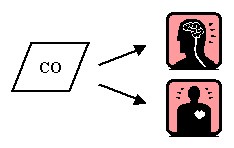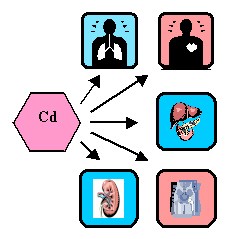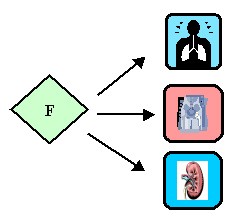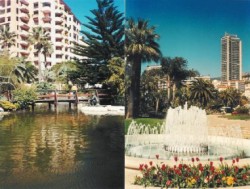|
|
 |
|
|
|
 |
| |
|
|
 |
Climate in cities
Read more |
Urban bioclimate
Bioclimatology is a branch of science dealing with the impact of weather and climate on living organisms, including humans. The urban climate may have negative effect on human body. We are exposed to chemical, physical and acoustic stimuli, e.g. air pollution, urban heat island and noise, respectively. |
|
|
|
|
 |
|
Urban climate effects human organism first of all by the influence of air pollution and noise. The presence of urban heat island modifies significantly human thermal comfort. Poor air quality effects directly human health. Transportation contributes usually to 20% of air urban pollution but it is most harmful as people breathe it in the streets, where it is concentrated, nearly straight from the emittors (see also "Energy..." and "Industry..."). The air pollution is another factor deteriorating urban bioclimate and living conditions. Below you can find some examples of the air pollutants and their influence on human organism. |
The sulphur dioxide (SO2), present in the urban air, causes increase of respiration system diseases' cases and higher risk of lung cancer. The main source of SO2 in urban air is combustion of fossil fuels, especially coal, e.g. in power plants.
|
 |
 |
 |
|
1. Impact of SO2 on human organism
Author: Sebastian Wypych
|
|
 |
 |
|
2. Impact of NOx on human organism
Author: Sebastian Wypych
|
|
 |
The nitrogen oxides (NOx) decrease the blood pressure and disturb the blood circulation, decrease the lungs' breathing efficiency and irritates eyes. The main source of NOx in urban air is combustion of fossil fuels, especially in transportation, and chemical industry. |
Breathing the urban air with carbon monoxide (CO) rises the risk of heart attack, coronary disease and circulatory system's diseases. Moreover, it replaces oxygen in blood and causes oxygen deficit in the body which may lead to injury of nervous system and brain or even to death. The main source of CO in urban air is combustion of fossil fuels, i.e. coal, oil, natural gas.
|
 |
 |
 |
|
3. Impact of CO on human organism
Author: Sebastian Wypych
|
|
 |
 |
|
4. Impact of Cd on human organism
Author: Sebastian Wypych
|
|
 |
Cadmium (Cd) accumulates in liver, kidneys and bones. It may cause lung cancer and osteporosis. It also enhances the blood hypertension. The main source of Cd in urban air is metallurgic and chemical industry, and coal combustion. Cadmium is not a very common compound of urban air but it is very harmful even in small amounts.
|
Another heavy metal, lead (Pb), accumulates in bones, and effects kidneys and nervous system, e.g. it can cause mental diseases. It is toxic for liver and weakens the eyes. The main source of Pb in urban air is metallurgic industry and coal combustion.
|
 |
 |
 |
|
5. Impact of Pb on human organism
Author: Sebastian Wypych
|
|
 |
 |
|
6. Impact of F on human organism
Author: Sebastian Wypych
|
|
 |
Fluorine (F) is needed by our body (e.g. bones, teeth) but in small amounts. Too high doses destroy bones, kidneys and lungs, it may cause lung cancer. The main source of F in urban air is metallurgic industry, e.g. aluminium works. Similar to cadmium, fluorine is not a very common compound of urban air but it is very harmful even in small amounts.
|
Tropospheric ozone (O3), which originates e.g. during the photochemical smog, irritates eyes and respiratory system, it can even partially destroy the upper respiratory system. The origin of tropospheric ozone is described in the text about "Ozone smog".
|
 |
 |
 |
|
7. Impact of O3 on human organism
Author: Sebastian Wypych
|
|
 |
 |
|
8. Impact of VOCs on human organism
Author: Sebastian Wypych
|
|
 |
Volatile Organic Compounds (VOCs) of natural origin (the phytoncides emitted by plants) are very good for human health as they kill bacteria present in the air. But those of anthropogenic origin may even cause lung cancer. VOCs play an important role in the formation of tropospheric ozone, together with NOx. The VOC-to-NOx ratio decides about the intensity of chemical reactions in the air, which cause the ozone formation. Increasing VOC concentration means more ozone, increasing NOx may lead to either more or less ozone depending on the prevailing VOC-to-NOx ratio. |
|
The emission of air pollution worsens sanitary conditions of a city, as it causes acid rains which then pollute ground waters and soils. Air pollution also decreases the amount of solar radiation reaching the ground by 10-30%, especially in the UV bound. The deficit of UV radiation may reduce the production of the vitamin D3 in human organism, which increases the risk of rachitis.
|
Noise
Recently noise is often included among the factors significantly deteriorating the living conditions in cities. Noise has negative impact on human nervous system and hearing abilities. According to the World Health Organization, in 2001 more than half citizens of Europe lived in noisy surroundings; a third experience levels of noise at night that disturb sleep. Main sources of noise are transportation, industrial production and large cities' services and traffic. The impact of noise on human health depends on its intensity, frequency and duration. People living in cities are often exposed to noise and therefore they suffer from headaches, problems with sleeping, and their efficiency at work decreases. Constant noise of the intensity 71-85 dB causes permanent weakening of hearing. When the intensity increases to 86-130 dB, the main functions of human body are disturbed. The value of 130 dB marks the threshold of physical pain.
|
 |
 |
 |
|
9. Urban traffic is a source of noise
Source: www.freefoto.com
|
|
|
Urban heat island has mostly negative impact on people, as human thermal comfort is controlled by the combination of thermal stimuli, i.e. short- and long-wave radiation fluxes, air temperature and humidity, and wind. The UHI weakens human thermal sensitivity, and resistance to thermal stress and temperature variability. Especially in summer, most cities' habitants feel overheating due to higher air temperature (resulting from e.g. increased heat absorption and storage of the building material, anthropogenic heat emission), high temperature of buildings and streets, but also due to low wind speed in the city centre. Hot air is not moved, which has negative impact on human thermal comfort. It is additionally intensified when the sultriness occurs, especially in summer. It occurs when air temperature is higher than 17°C, relative humidity exceeds 85% and vapour pressure is larger than 18.8 hPa, while wind speed is close to zero. The sultriness causes worse thermoregulation of a human body because it slows down evaporation of sweat. That process cools down our body and protects us from overheating.
|
|
Human organism has large abilities to adopt to changing thermal conditions. Thermoregulation allows to keep the thermal balance. When the body temperature increases, the blood-vessels widen and more blood can be transported, which facilitates the body cooling. Moreover, increased amount of sweat is produced as it also improves the body cooling; the evaporation of sweat uses the heat of human body.
|
To reduce the negative impact of urban climate on people, the share of parks and lawns in urban areas should be increased. Green areas "filter" the air, as plants catch and retain the air pollution (air pollution can be lower in a park even by 20-40% in comparison with the rest of a city). Plants produce oxygen which improves the air quality. In summer, green areas also decrease air temperature, due to shading the ground (which means that less solar energy can reach the ground, be absorbed and radiated back to the air as heat), and less heat accumulation in comparison with streets and buildings. The soil surface temperature in a park may be lower by even 12oC than the temperature of a street surface. City parks decrease air temperature by about 15% comparing to the rest of a city. Moreover, green areas increase air humidity, reduce the thermal stress and enhance local air circulation and deaden noise.
|
 |
 |
 |
|
10. Ponds and fountains in a city reduce the negative impact of urban climate on people
Photos: Sebastian Wypych
|
|
|
About this page:
Authors: Sebastian Wypych, Anita Bokwa - Jagiellonian University - Cracow / Poland
Supporter: Anna Gorol
1. Scientific reviewer: Prof. Barbara Obrebska-Starkel - Jagiellonian University - Cracow / Poland - 2003-06-20
2. Scientific reviewer: Dr. Marek Nowosad - Maria Curie-Sklodowska University - Lublin / Poland - 2003-06-16
3. Scientific reviewer: Dr. Andreas Matzarakis - University of Freiburg / Germany - 2003-09-15
educational reviewing:
last update: 2004-01-31
|
|
 |
|









